|
|||||||||||||||
Vol. 18, No. 35, FEBRUARY 27, 2006 |
|||||||||||||||
The Friday Program:
David got off on firm footing by telling his audience that his dad was a Rotarian in Boston. A technical glitch kept David from getting his PowerPoint presentation up and running initially, causing him to mutter, “This is a lot tougher than neurosurgery.” President Lingenbrink returned, refreshed from his research trip to Maui, to introduce Jim Owens for the Invocation and Pledge. Mitch Freedman gave his audience lots of laughs as he worked his way through the greeting process. Ruben Ladlad made the point that donations through your business or as individuals are very helpful to Rotary First Harvest. The month-long salute to this important District program came to an end with the reminder about RFH Gift cards which are available for purchase, which is then applied to a donation to First Harvest. The gift card is a very handy way of showing your support for Rotary’s First Harvest program. And, don’t forget, Saturday March 11 is the next RFH Work Party at Pier 91 – 9:00 a.m. to Noon. Bring family members 12 and older and help get nutritious food distributed to food banks throughout the state.
Kirkland Breakfast Club Earns Provisional Status District Governor Sally Gray announced that the new Rotary Club of Kirkland Breakfast has been granted provisional status, with the news that Pat Trudell was selected the Charter President, agreeing to serve through the 2006-2007 year. DG Gray gave special thanks to Joanne Primavera, President of the Rotary Club of Kirkland, and to Steve Lingenbrink, President of the Bellevue Breakfast Rotary Club, both acting as the new club’s sponsors. Assistant Governor Bill Taylor and District Club Extension Chairman Duane Ruud were also praised for their part in the new club forming. President Trudell, who happens to be a partner with Lingenbrink in the Kirkland law firm, will be attending PETS while the new club grows in numbers. The club charter night is tentatively scheduled for early April, so the new Rotarians can attend the District Conference “without the provisional tag.” The Rotary Club of Kirkland Breakfast meets Tuesday mornings at 7:15am at the Crab Cracker, 452 Central Way in Kirkland. BBRC members are encouraged to attend meetings with the new club, help them get going with a head of steam, and giving the visitors a make-up at Rotary’s newest club.
Ballard read the answers, the contestants gave the questions. For instance, “What was the gift that Dick Clarke gave his new bride for a wedding gift?” The answer was “A mop.” By the time the smoke had cleared, Curt Cummings had garnered 100 points, Margie Burnett, 400, and Rick McManus, 700. The Final Jeopardy Round saw each contestant wager a part or all of their winnings on getting the right answer. With the bets all in, Ballard said, “The youngest person to be president of the BBRC.” All three contestants answered “Who is Steve Goldfarb?” Alas, the answer was John DeWater. McManus had the most to lose but bet a smaller amount and ended up with the most points. A big hand for all of those playing Jeopardy. For the pay-off, all of the seniors represented by Rick McManus paid nothing, The Female Rotarians, represented by Margie Burnett, who came in second, paid $1.00 each for second place, and the newcomers paid $2.00 for Curt’s run at the title. The Friday Program:
David got off on firm footing by telling his audience that his dad was a Rotarian in Boston. A technical glitch kept David from getting his PowerPoint presentation up and running initially, causing him to mutter, “This is a lot tougher than neurosurgery.” The incidence of major brain and nervous system disorders makes the expansion of the neuroscience services possible. “We are learning new ways to treat a variety of diseases with great success. Our goal would be to reduce costs for treatment and yet keep the quality high.” In the Providence campus of Swedish Medical Center, you’ll find an equal emphasis on neuroscience and cardiovascular technologies. “We have the first Interventional Cardiology on the West Coast,” said Dr. Newell. “Neuroscience development will affect lives in positive ways. The various treatments available include neurovascular, brain tumors, spine trauma,
Something called a “Stereotaxis Magnet System” helps to place coils and clips in aneurysms without surgery. “This technology has exploded and is a major advance to patients who can’t have surgery. Interoperative Portable MRI technology help us determine how best to treat these aneurysms.” Stroke is the #1 cause of disability in US. Stroke is the leading cause of long-term disability among adults in the United States and the third leading cause of death (behind diseases of the heart and all forms of cancer). Nearly 700,000 people suffer new or recurrent stroke each year, and almost 165,000 die of the condition. The Swedish Stroke Program is a state-of-the-art stroke prevention and treatment program, providing a seamless system of handling patients from the emergency room through rehabilitation. It is yet another program offered by the Seattle Neuroscience Center. There are other words we are just being introduced to. For instance, there’s “clotbust” and "recanalization,” both having to do with breaking up clots in arteries and redirecting blood flows around certain blockages.
Another technique is called “imaged guided surgery," particularly adept at treating Parkinsons disease. Neurostimulation is a new science in the treatment of spinal injuries and disease. Seattle Neuroscience Center is a new paradigm for neuro technology. Part of its work will be in conducting clinical trials and consulting and partnering with industry to continue the search for new and innovative ways to serve the public. With Seattle’s geographic position in the Pacific Rim, the new Institute will provide the same quality care or better in a variety of new technologies. The James Tower, housing the Seattle Heart and Neuroscience Center, will be opening in a month, all part of the Providence campus of the Swedish Medical Center. It’s a world-class institute, attracting the best people to participate and embracing and developing new technologies. For more information about the Seattle Neuroscience Institute, access www.swedish.com and click on Seattle Neuroscience Institute. For his presentation, Dr. David Newell received a certificate showing that a book has been donated in his name to the Ready to Read program of the King County Library System.
Q. What does HMO stand for? A. This is actually a variation of the phrase, "HEY MOE." Its roots go back to a concept pioneered by Moe of the Three Stooges, who discovered that a patient could be made to forget the pain in his foot if he was poked hard enough in the eye. Q. I just joined an HMO. How difficult will it be to choose the doctor I want? A. Just slightly more difficult than choosing your parents. Your insurer will provide you with a book listing all the doctors in the plan. The doctors basically fall into two categories--those who are no longer accepting new patients, and those who will see you but are no longer participating in the plan. But don't worry, the remaining doctor who is still in the plan and accepting new patients has an office just a half-day's drive away and a diploma from a third world country. Q. Do all diagnostic procedures require pre-certification? A. No. Only those you need. Q. Can I get coverage for my preexisting conditions? A. Certainly, as long as they don't require any treatment. Q What happens if I want to try alternative forms of medicine? A. You'll need to find alternative forms of payment. Q. My pharmacy plan only covers generic drugs, but I need the name brand. A. Poke yourself in the eye. Q. What if I'm away from home and I get sick? A. You really shouldn't do that. Q I think I need to see a specialist, but my doctor insists he can handle A. Hard to say, but considering that all you're risking is the $20 co-payment, there's no harm in giving it a shot. Q. Will health care be different in the next century? A. No, but if you call right now, you might get an appointment by then. |



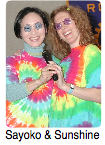 A bright light of sunshine came bouncing in the room, as Wendi Fischer portrayed “Sunshine,” in her lively tie-dyed outfit, to promote the March 16 New Member Mixer at Wendi’s house in Redmond. The theme is “Be Happy,” and the first 20 people to sign up will get a tie-dyed shirt! This is another one of the Sayoko Productions and you better believe you’ll have a great time! Thursday, March16, 6:30 to 8:30pm at the Fischer Home.
A bright light of sunshine came bouncing in the room, as Wendi Fischer portrayed “Sunshine,” in her lively tie-dyed outfit, to promote the March 16 New Member Mixer at Wendi’s house in Redmond. The theme is “Be Happy,” and the first 20 people to sign up will get a tie-dyed shirt! This is another one of the Sayoko Productions and you better believe you’ll have a great time! Thursday, March16, 6:30 to 8:30pm at the Fischer Home.
 David W. Newell, M.D., gave a head-spinning talk on the advances being made in his chosen field of neurosurgery. He is medical director of the newly established Seattle Neuroscience Institute at Swedish Medical Center. The Executive Director of the Institute is Marc Mayberg, M.D. These two top neurosurgeons are leading a major expansion of neuroscience services at Swedish to better serve the region and the aging population.
David W. Newell, M.D., gave a head-spinning talk on the advances being made in his chosen field of neurosurgery. He is medical director of the newly established Seattle Neuroscience Institute at Swedish Medical Center. The Executive Director of the Institute is Marc Mayberg, M.D. These two top neurosurgeons are leading a major expansion of neuroscience services at Swedish to better serve the region and the aging population. Friday Potpourri
Friday Potpourri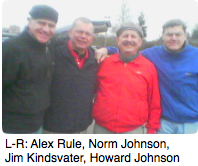 A small turnout for the attack on 405 at SE 8th last Saturday. Preserve Planet Earth Committee commends Chair Chip Erickson, and clean-up crew Chuck Barnes, Alex Rule, Norm Johnson and Jim Kindsvater for their work Saturday morning. Everyone arrived home safely! Thanks, crew!
A small turnout for the attack on 405 at SE 8th last Saturday. Preserve Planet Earth Committee commends Chair Chip Erickson, and clean-up crew Chuck Barnes, Alex Rule, Norm Johnson and Jim Kindsvater for their work Saturday morning. Everyone arrived home safely! Thanks, crew!
 Joining the BBRC on September 30, 2005, Hal Teel informed the membership he was born and raised in Southern California. He married Sherry in 1967 and they have two sons. Bryan, 32, lives in San Diego with his wife Luciana and son Lucas — who has citizenship in three countries: U. S., Brazil and Italy (Luciana is of Italian descent, born in Brazil. Italian law says that citizenship follows the mother, so Lucas will carry three citizenships with him. Hal's other son, 30-year-old Cullen, is married to Hanna and they have a daughter, Auren. Cullen teaches at a Maritime school in Rockland, Maine.
Joining the BBRC on September 30, 2005, Hal Teel informed the membership he was born and raised in Southern California. He married Sherry in 1967 and they have two sons. Bryan, 32, lives in San Diego with his wife Luciana and son Lucas — who has citizenship in three countries: U. S., Brazil and Italy (Luciana is of Italian descent, born in Brazil. Italian law says that citizenship follows the mother, so Lucas will carry three citizenships with him. Hal's other son, 30-year-old Cullen, is married to Hanna and they have a daughter, Auren. Cullen teaches at a Maritime school in Rockland, Maine. Chris Ballard put on his Alex Trebek hat and staged the 20th Jeopardy Challenge, coinciding with
Chris Ballard put on his Alex Trebek hat and staged the 20th Jeopardy Challenge, coinciding with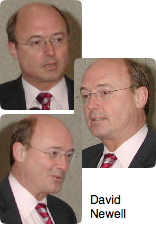 David W. Newell, M.D., gave a head-spinning talk on the advances being made in his chosen field of neurosurgery. He is medical director of the newly established Seattle Neuroscience Institute at Swedish Medical Center. The Executive Director of the Institute is Marc Mayberg, M.D. These two top neurosurgeons are leading a major expansion of neuroscience services at Swedish to better serve the region and the aging population.
David W. Newell, M.D., gave a head-spinning talk on the advances being made in his chosen field of neurosurgery. He is medical director of the newly established Seattle Neuroscience Institute at Swedish Medical Center. The Executive Director of the Institute is Marc Mayberg, M.D. These two top neurosurgeons are leading a major expansion of neuroscience services at Swedish to better serve the region and the aging population.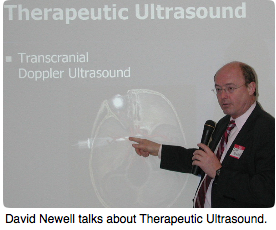 Surgical development, new drug development, industry partnering (Siemens and Phillips, to name a couple), exploring key technologies such as imaging and diagnostics, therapeutic ultra sound, and brain computer interface are just some of the areas of expertise.
Surgical development, new drug development, industry partnering (Siemens and Phillips, to name a couple), exploring key technologies such as imaging and diagnostics, therapeutic ultra sound, and brain computer interface are just some of the areas of expertise. The brain computer interface is another “exploding technology,” which includes such tongue-twisters as “stereotactic radiosurgery” (a way to treat tumors in the brain which brings to bear precisely-focused radiation).
The brain computer interface is another “exploding technology,” which includes such tongue-twisters as “stereotactic radiosurgery” (a way to treat tumors in the brain which brings to bear precisely-focused radiation). 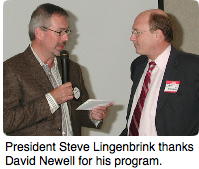 Thanks to Greg Hendershott for his program introduction and for bringing his wife Liz, who has worked with Dr. Newell on medical projects before.
Thanks to Greg Hendershott for his program introduction and for bringing his wife Liz, who has worked with Dr. Newell on medical projects before.  MEDICAL INSURANCE EXPLAINED
MEDICAL INSURANCE EXPLAINED